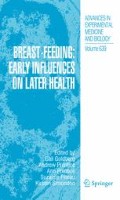It has long been known that breast-feeding does more than simply nourish the baby. Human milk contains a large number of so-called non-nutritional substances. Those that have been most fully studied are protective factors, such as immunoglobulin A (IgA) and lactoferrin, which have been shown to defend the neonatal gut from the adverse affects of microorganisms and foreign food proteins. However, an abundance of other substances in milk, many ‘bioactive’ such as hormones and trophic factors, has raised the suggestion that some may be messages from mother, destined to play a role in infant metabolism. To make the journey from maternal breast to infant circulation such ‘signals’ must pass across the infant gut wall intact on their way to their site of action.
Access this chapter
Tax calculation will be finalised at checkout
Purchases are for personal use only
Preview
Unable to display preview. Download preview PDF.
References
Peaker M, Neville MC (1991) Hormones in milk: chemical signals to the offspring. J Endocrinol 131:1–3.
Wilson JM, Casanova JE (2000) Development of endocytosis in the intestinal epithelium. In: Development of the Gastrointestinal Tract, (IR Sanderson and WA Walker, eds), London, Decker, pp 71–81.
Weaver LT (1996) Anatomy and embryology of the gastrointestinal tract. In: Pediatric Gastrointestinal Disease (2nd edition), (WA Walker, PR Durie, JR Hamilton, JA Walker-Smith, JB Watkins, eds), Mosby, New York, pp 9–30.
Weaver LT, Walker WA (1989) Uptake of macromolecules in the neonate, In Human Gastrointestinal Development. (E Lebenthal ed), Raven Press: New York, pp 731–48.
Weaver LT (1992) Breast and gut: the interrelation of lactating mammary function and neonatal gastrointestinal function. Proc Nutr Soc 51:155–163.
Weaver LT (1993) Egg, placenta, breast and gut: comparative strategies for feeding the young. Endocrine Regulations 27:95–104.
Colony-Moxey P, Trier JS (1979) Development of villous absorptive cells in the human fetal intestine: a morphological and morphometric study. Anat Rec 195:463–482.
Calvert R, Beaulieu J-F, Menard D (1982) Epidermal growth factor accelerates maturation of fetal intestinal mucosa in utero. Experientia 38:1096–1097.
Conteas CN, De Morrow JM, Majamnur APN (1986) Effect of epidermal growth factor on growth and maturation of fetal and neonatal rat intestine in organ culture. Experientia 42:950–952.
Goodlad RA, Wilson TJG, Lenton W, Gregory H, McCulagh KG, Wright, NA (1987) Intravenous but not intragastric urogastrone-EGF is trophic to the intestine of parenterally fed rats. Gut 28:573–582.
Playford RJ, Woodman AC, Clark P et al (1993) Effect of luminal epidermal growth factor on intestinal growth. Lancet 341:844–848.
Berseth CL, Go VL (1988) Enhancement of neonatal somatic and hepatic growth by orally administered epidermal growth factor in rats. J Pediatr Gastroenterol Nutr 7:89–93.
Weaver LT, Gonnella PA, Israel EJ, Walker WA (1990) Uptake and transport of epidermal growth factor by the small intestinal epithelium of the fetal rat. Gastroenterology 98:828–837.
Gonnella PA, Siminoski K, Murphy RA, Neutra MR (1987) Transepithelial transport of epidermal growth factor by absorptive cells of suckling rat jejunum. J Clin Invest 80:22–32.
Kong WY, Koldovsky O, Rao RK (1992) Appearance of exogenous epidermal growth factor in liver, bile and intestinal lumen of suckling rats. Gastroenterology 102:661–667.
Shen WH, Xu RJ (1998) Stability and distribution of orally administered epidermal growth factor in neonatal pigs. Life Sci 63:809–820.
McCuskey RS, Nishida J, McDonnell D, Williams C, Koldovsky O (1997) Effect of milk-borne epidermal growth factor on the hepatic circulation and Kupffer cell function in suckling rats. Biol Neonate 71:202–206.
Koldovsky O (1994) Hormonally active peptides in human milk. Acta Paediatrica (suppl) 402:89–93.
Weaver LT, Laker MF, Nelson R (1984) Intestinal permeability in the newborn. Arch Dis Child 59:236–241.
Weaver LT, Freiberg E, Israel EF, Walker WA (1988) Epidermal growth factor in human amniotic fluid. Gastroenterology 95:1436.
Moran JR, Courtney ME, Orth DN et al (1983) Epidermal growth factor in human milk: daily production and diurnal variation during early lactation in mothers delivering at term and premature gestation. J Pediatr 103:402–405.
Beardmore JM, Lewis-Jones DI, Richards RC (1983) Urogastrone and lactose concentrations in precolostrum, colostrum and milk. Pediatr Res 17:825–828.
Menard D, Pothier P (1991) Radiographic localization of epidermal growth factor receptors in human fetal jejunum, Gastroenterology 101:640–649.
Britton JR, George-Nascimento C, Udall JN, Koldovsky O (1989) Minimal hydrolysis of EGF by gastric fluid of preterm infants. Gut 30:327–332.
Gale SM, George-Nascimento C, Wallace JC, Ballard FJ (1989) Is dietary epidermal growth factor absorbed by premature human infants? Biol Neonate 55:104–110.
Author information
Authors and Affiliations
Editor information
Editors and Affiliations
Rights and permissions
Copyright information
© 2009 Springer Science + Business Media B.V.
About this chapter
Cite this chapter
Weaver, L.T. (2009). Transenteric Signalling: Mammary Messages or White Noise?. In: Goldberg, G., Prentice, A., Prentice, A., Filteau, S., Simondon, K. (eds) Breast-Feeding: Early Influences on Later Health. Advances in Experimental Medicine and Biology, vol 639. Springer, Dordrecht. https://doi.org/10.1007/978-1-4020-8749-3_7
Download citation
DOI: https://doi.org/10.1007/978-1-4020-8749-3_7
Publisher Name: Springer, Dordrecht
Print ISBN: 978-1-4020-8748-6
Online ISBN: 978-1-4020-8749-3
eBook Packages: Biomedical and Life SciencesBiomedical and Life Sciences (R0)

